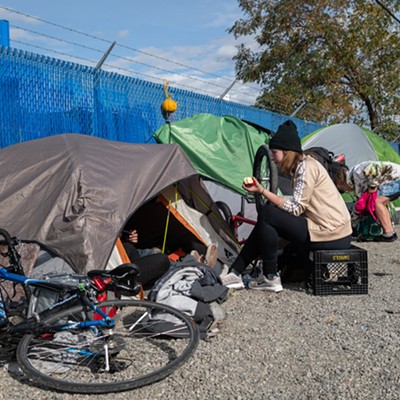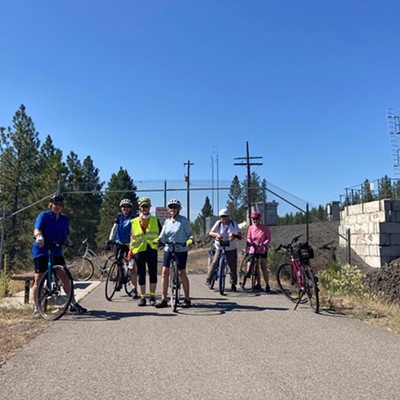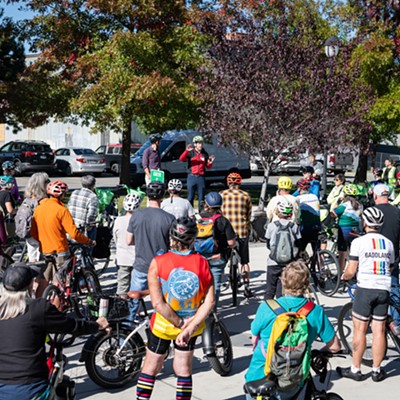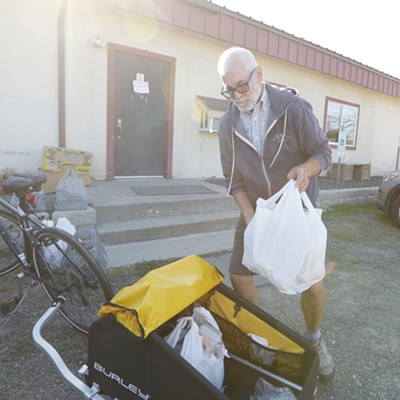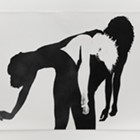I got schooled by eight geezers in Lycra shorts last Thursday. I'm not proud.
When I met up with the Spokane Bicycle Club on the South Hill at 9 am, I felt good, even a little cocky. Sure, the eight cyclists who showed up for the club's morning ride looked a little daunting in their racing outfits and their fancy, ultra-light road bikes. But I also couldn't help but notice that I had at least 15 years on all of them. With few exceptions, this was a group of retirees. I could dust these old-timers!
Within minutes, we were in the middle of nowhere, peeling south of the city on the Palouse Highway. I took some pleasure in passing to the front of the group, trying not to appear winded, chatting with fellow riders as the rest, who all seemed to know each other well, talked about mutual friends, or what they were reading. Leonard Urgeleit, in his recumbent bicycle, sang.
On a brutally long, steep hill on Valley Chapel Road, I left most of them far behind, springing to the peak to meet Ron Jones, a 40-something triathlete who had us all beat when it came to climbing. We rested at the little white Mount Hope chapel on Kentuck Trails Road, then flew south through the green and gold rolling hills of the Palouse — the sun shining, the insects in the bushes along the road buzzing like French cycling fanatics. Where, I wondered, had these roads been all my life?
But then came the punishingly long, gradual hill that led out of the little town of Rockford. I hit the wall. I bonked. Like Floyd Landis on La Toussuire. My neck ached. I could feel the strength draining from my legs. I had a headache. I was starving. And way off in the distance, way up near a bend where the road simply disappeared, I could see the deep blue jersey of Al Koscal, the day's ride coordinator, his tanned calves like great, muscular turkey drum sticks, pumping vigorously at his pedals.
I cracked.
By the time we returned to the South Hill — 15 miles and a seemingly endless procession of hills later — I was spent, my face red, a wobble in my cadence. But Al, a retired Navy pilot, looked like he just awoke from a power nap. The day's 42-mile circuit was child's play for the Spokane Bicycle Club, whose members go on rides like this about eight times a week.
"You know, we're just a recreational riding group," he says. "There are other groups that ride a lot faster." I don't know whether this was meant to be informative or just cruel. But as the club headed off to a group lunch at Okane, I pedaled home in pain and spent the next hour on the floor of my apartment, wishing never to set eyes on a bicycle ever again.
This time of year, there's at least one group like this pulling up kickstands in some corner of Spokane every day of the week. That's not counting special touring rides, like the Tour des Lacs, or the upcoming Eight Lakes Leg Aches. The Spokane Bicycle Club alone heads out on eight rides weekly, from medium-level tours like the one I joined to long, challenging climbs, family excursions and mountain bike spins. Then there's Baddlands Cycling Club and Spokane Rocket Velo, two fast-paced teams that put on multiple trips a week. Or there's the WOW Babes Cycling Club, or Fat Tire Trail Riders, or any number of rides put on by local bike shops.
Do the math. There's a good chance that right now, somewhere in the city, there's a cyclist building a mountain bike trail in the woods, or climbing up Mount Spokane, pedaling to work or just riding to the Elk for a beer.
That may come as a surprise. Spokane isn't exactly known for being a bike town: Where are the bicycle lanes? Where are the two-wheel commuters? Where are the arrogant messengers chugging Pabst on their track bikes?
It's not that kind of bike town. Those lanes haven't been striped. Potential commuters haven't gotten over the fear of potholes and reckless drivers. The cycling scene here is alive and well, but it's not obvious, it's not trendy and it hasn't been handed to riders on a silver platter the way it has in other cities. It's hidden away — on trails in the woods, in abandoned lots, out on the open road — and cyclists are building it one pedal stroke at a time.
Take Joe Perrizo, a Spokane kid who believes riding his bike around the South Hill kept him straight when he was younger.
"In any town, there's a lot of high risk for getting in trouble, whether it be drugs, drinking or vandalizing stuff. If I didn't have a bike when I was 13, I'da been running around, stealing or smashing pumpkins for kicks. I don't know how else to put that."
A mechanic at Wheel Sport, Perrizo started racing when he was 13 years old, competing in dual slalom and cross-country events. In the nine years since, he's busted 30-some forks and taco-ed more rear wheels than he can count, but he still hasn't broken a bone. And he's now one of the best mountain bikers in Spokane -- and arguably one of the best in the country.
He'll find out for sure in a few weeks, when he travels to Whistler, B.C., for one of the biggest free-style bike competitions in the world. He'll be competing in jump jam and slope-style competitions with riders from throughout North America and Europe.
Then, in the middle of August, he and Coeur d'Alene's Steve Bafus will be two of only 30 riders to compete in an invitational slope-style competition in Snowshoe, W.Va., where they'll throw themselves off 30-foot ramps and fly across gaps of 20 to 50 feet.
He learned this outlandish behavior in Spokane, where a labyrinth of mountain bike trails run all throughout the area -- from the dirt ramps of Spokane Valley to the treasures of Beacon Hill at Camp Sekani, to the 120-mile network in Riverside State Park. Mountain bikers in Spokane not only don't have to throw their bikes on top of their cars to get to good riding (as they do in more traditionally bikeable cities like Seattle or Portland), they can literally get all the way across town on almost nothing but public and private trails -- from the South Hill to Seven Mile, from Riverside to Liberty Lake.
"Spokane's definitely got a great bike scene, from road riding to freestyle to street riding, dirt jumping. I'd call it a bike town. The last couple of weeks, every Wednesday night, me and some of the guys from the [Spokane] Valley Wheel Sport have been going downtown and tearing up the streets, jibbing on stuff down there," he says. "There are some bad-ass kids who ride BMXs here -- a bunch of kids downtown I ride with [who] are just killer."
Of course, despite his success, he's not quitting his day job. But he might get a little distracted truing a wheel these days, as he dreams of the scene in Europe, where spectators mob bike events and riders are rock stars. He's not quite there yet, but he's getting close.
"People used to bitch or yell at me for riding on picnic tables when I was a kid, but now people give me more respect," says Perrizo. "Maybe because I'm older, or maybe because they think what I'm doing is hella cool."
While most people sat inside sucking up A.C. and icy mojitos on Saturday, Craig Gracyalny became the 2006 Washington State time trial champion cyclist out in Cheney. But he can't tell you much about it, because he doesn't really remember it.
Gracyalny, a rider with Spokane's Baddlands Cycling Club, was diagnosed in the fall of 2002 with multiple sclerosis, a condition that makes him susceptible to extreme heat -- like that on Saturday, when temperatures on Highway 904 hit 104 degrees and caused the computer that kept track of racers' times to overheat and seize up.
The 42-year-old supervisor of Sacred Heart Hospital's nuclear medicine department has been with Baddlands (the group that hosted the weekend race) for four years, becoming the No. 1-ranked Masters' Stage racer in the country in 2004. Yet halfway into his ride on Saturday, he started to feel pretty lousy. But he didn't stop. "What the hell," he recalls thinking. "It's the state championship." With five miles to go on the 40-kilometer course out to the town of Tyler and back, he started to feel queasy but gave himself 10 more minutes.
He doesn't remember the last two miles. Or crossing the finish line with a time of 57 minutes and 59 seconds. Or passing out on the side of the road 100 yards beyond the finish line and being carted off in an ambulance. He certainly doesn't remember Spokane race promoter Gino Lisecki calling out his name as the first-place winner an hour later. By then he was sitting at Sacred Heart.
Sounds crazy, but Gracyalny is part of a healthy -- and growing -- body of serious road racers in Spokane. That's no surprise to Lisecki. Described by some as the "sage of the bike community," he's been throwing races in Spokane and elsewhere for 20 years and helped bring the Olympic cycling trials to town before the 1984 and 1988 Olympics.
"This used to be a Mecca for racing in the 1980s," he says. "Lance Armstrong, George Hincapie, Bobby Julich -- they all raced here as juniors."
He and Tim Arnold, owner of the Bicycle Butler shop on North Ash Street, agree that road biking has been making a comeback in the last few years, though they can't finger a single reason for it -- possibly something to do with a growing fitness movement, or maybe Armstrong's string of seven consecutive wins in the Tour de France.
There are some great local riders, like Michael Emde, Mark Knockey and Andrew McDirmid, a local accountant who won the Master Nationals, 30- to 34-year-old class, at Park City, Utah, in 2004.
Whatever the case, Lisecki -- like nearly everyone we talked to for this story -- says there are definitely more riders on the roads these days, citing a surge in attendance for road rides like the Tour des Lacs, which he produces with Round and Round, his sports events management company.
He adds that it's a natural fit for Spokane, with its seemingly infinite array of scenic country roads. He points out that many of the racers who showed up for the time trials -- from Bainbridge Island, Walla Walla and all over Washington -- will stick around for the night and ride in the next day's Rosalia-Rock Lake Classic, which is put on by the other big local race squad, Spokane Rocket Velo.
"It's an interesting community of people," says Gracyalny. "Kind of small in its own way but really good at working together."
They work together because it's the only way. Spokane's cyclists have forged a bike scene with little help from their host city. Think about it: Spokane's got time trials, road races, bike workshops, national competitions, national champions, historical cameos from cycling legends, guys throwing themselves off rocks and up ramps, kids riding on picnic tables to stay out of trouble, trails, trails, more trails, back-door access to rolling country roads and treacherous mountain climbs. With all this, you'd think the city would be bicycle heaven. Near Nature, Near Perfect. You'd think it'd be a consistent contender in Bicycle magazine's famous annual assessment of America's most bike-friendly cities.
You'd be wrong.
While cities like Portland, Chicago, Boulder and Davis, Calif., have all made regular appearances on the list over the last decade, Spokane hasn't made the cut once. And bicycle advocates say it's not because the cycling community lacks enthusiasm. Nor do they believe the common excuses that Spokane's too hilly to be a true bike town (look at bike-friendly San Francisco) or too hot in the summer (look at Chicago) or too cold in the winter (look at Madison, Wis.).
The reason, they say, is because local government just doesn't get it.
Case in point: At last week's Spokane City Council meeting, the council proclaimed July 19 official "Ride to Work" day. Great, we thought, as they began the proclamation. It's nice to see the council embracing cycling as a viable means of transportation and commuting. Especially with gas prices the way they are. How very progressive of them. But then they continued. They didn't mean ride your bike to work; they meant ride your motorcycle or scooter to work. Saves gas, good for the environment. Al French, who calls his preferred ride -- a Honda Gold Wing-- a "recliner on wheels," notes that the proclamation came down from the mayor's office. Even he's not sure why it didn't involve bicycles.
Even worse, when Rock Shox -- the company that practically invented the shock absorber technology used in almost all mountain bikes today -- was shopping for a new home for its headquarters several years ago, it visited Spokane, a city with great mountain bike riding. But did city officials toss them helmets and take them out for a ride? No. They talked numbers, just like they would with any other company.
"These engineers didn't give a damn about tax incentives and the like," Chris Kelly, then director of the Entrepreneurs Forum of the Great Northwest, told us in 2002. "They were just interested in the coolest place to represent their product."
City officials in Colorado Springs, Colo., took them out riding, though. And that's where Rock Shox relocated.
"The capacity is here, the opportunity is here," says Sally Lodato, a store manager at REI and the outgoing director of the city's Bicycle Advisory Board. But the city isn't moving on that, she says. "It's not pro-active in looking at biking as a viable means of transportation, as a viable means of recreating within the city, [and] not just a recreation trail. It's also not regarded as viable in economic development, at least through [its] actions. Many communities are passing us by."
Eileen Hyatt knows the city's bike routes better than nearly anyone in town. A former member of the city's Bicycle Advisory Board, an organization that's meant to serve as the voice of the bicycling community in planning issues, the Spokane native is one of the city's foremost bike advocates and one of the people working hardest to make sure city officials get it. On Friday, she took me on a tour of city sites where they don't.
From The Inlander's downtown office, we ride north through Riverfront Park to Buckeye. Hyatt, who teaches courses in bike safety and urban riding, keeps pulling over and offering me pointers: Take the lane, plan for intersections before you reach them, look over your shoulder and make eye contact with drivers coming up behind you. "It makes them see you're human," she says. "It calms them down, quells their desire to just charge past an impediment." Cycling, she says, is a "social and visual interaction."
We pedal to Mayfair Street, a block east of the intersection of Ruby Street and Foothills Boulevard on Spokane's north side. Because it's illegal to ride on neighboring Division north of the hill (this is the only street in town that bars bike traffic), the city has provided a north-south alternative on Mayfair. The street is even marked with Bike Route signs. But to get there from the new bike lanes on Buckeye, west of Division, we have to cross through two busy intersections, change lanes a couple of times, then veer left across two lanes of uncontrolled traffic. At the bottom of the hill on Mayfair we're faced with three signs: Bike Route, Dead End and Road Closed to Thru Traffic.
Well, which is it?
A third of the way up the hill, Mayfair narrows to one lane, closed to motorized thru traffic, which is great. But the path is overgrown with weeds, and it's blocked by a giant sign that says the road is closed. To get around you have to either pedal through the bushes on the right, or swerve into the downhill traffic on the left. "Welcome to Spokane," Hyatt chuckles.
At the top of Wall Street, just south of the Milk Bottle, we stop and Hyatt warns me that the hill below can be very dangerous, that a cyclist died on this stretch about a year ago. She explains that she worked with the city to try to require the owner of a large apartment complex at the bottom of the hill to keep the corner of Wall and Cora Street visually clear, because if they were to fence the property in, cars pulling onto Wall from Cora wouldn't be able to see traffic coming down the hill. But then the apartment owner built a chain-link fence. Then wove wooden slats into the chain-link fence. Then put up a vacancy sign on the very corner. And sure enough, as we speed down the hill -- just as we're about to pass the apartment complex -- a big, long boat of a car comes lurching blindly into Wall, the driver looking the other way. My heart stops. My front tire wobbles. The driver finally sees us and we coast to the flats, where Hyatt gives me a look like, "What did I tell you?"
Further down, she notes that where Wall curves around to Post there were supposed to be, if not bike lanes, at least wide lanes to accommodate cyclists. There aren't. When the street first opened, Hyatt called the Public Works director at the time to lambaste him. "It's temporary," he told her. Temporary? The street is lined with broad sidewalks and leafy trees. "I forgot," the engineer admitted.
"Letting an engineer design your city is like putting a surgeon in charge of your overall health," she says. "He's good at what he does, but he doesn't have the bigger picture."
None of this is to suggest that the city's leaders are openly hostile to bikers (despite reports of police overreaction from last fall's Critical Mass rides). After all, we have all those aforementioned trails -- and the Centennial Trail, a 40-mile bike and ped path stretching from here to Coeur d'Alene. Groups like REI and the Friends of the Centennial Trail are even working with the city to connect it with the Fish Lake Trail, which will give users a route to Cheney.
And we do have bike lanes, which are well-documented in a new map produced by the Bicycle Advisory Board and the Spokane Regional Transportation Council, the county's planning arm, which has proven to be a friend to the bicycling cause (the maps are now available for free at most bike shops). Spokane County has also created the Commuter Trip Reduction program, which works with some of the area's largest employers to promote alternatives to solitary car commuting -- via biking, walking, car pools and work-from-home. And since Spokane Transit Authority outfitted its bus fleet with bike racks in 1994, it has issued more than 32,000 permits to riders, who simply watch a short instructional video then get to use the racks for free.
This is also not to say that the city of Spokane completely lacks vision. It does have a bicycle plan on the books, and cycling commands a weighty section of the city's Comprehensive Plan, which declares that "bicycling should be a viable transportation option" and that it "needs to be respected and accommodated." The plan calls for bike lanes, driver education and commuter locker and shower facilities.
Sally Lodato, with the Bicycle Advisory Board, points to this as proof that there are people within City Hall who do get it, but she notes that they're not the decision-makers. And when the decision-makers aren't sticking to the plan, nobody else is inclined to, either.
"There's a lot in the Comp Plan. There's a lot in the ordinances. It looks like we're doing a lot. The reality is it's not happening. It does go back to budget and resources ... It's not any fun to get the boilerplate reply, 'There's no money to do this.' That's not good enough ... I've found if it's a priority, money is found."
Without strong leadership in City Hall -- without personnel whose job it is to remind civil engineers and city planners to stick to the plan -- Spokane is left with a system of scattered, broken bike lanes and badly maintained bike routes. Which is exactly what doesn't win cities awards for bike friendliness.
Communities like Chicago, on the other hand, have thrived on the aggressive leadership of their city officials. Mayor Richard Daley has made it his mission to make his city the most bike-friendly in the country, backing a multimillion-dollar program to add 200 miles of bike routes with signage and 25 new miles of bike lanes to its current reserve of 120 miles. In 2004, Chicago opened a bike station in Millennium Park. For $100 a year (or about three tanks of gas), members can park their bikes at the station, take a shower, stow their gear in a locker, shop for all their bike commute necessities and have the station's mechanic fix their busted spoke or flat tire while they're at work. The station, in the heart of downtown, holds up to 350 bikes. If that's not enough to stir a worker bee to get her bike down from the attic, we don't know what is.
Portland, which Bicycling magazine named the country's most bike-friendly city in 1995 and again in 1999 and 2001, has striped in 225 miles of bike lanes, boulevards and multi-use trails over the last 25 years and outfitted its bus fleet and two light rail systems for easy bike access. Mayors, council members and the city's U.S. Congressman have all stood up for the cause. In 1996, the city cut a deal with five local athletic clubs to give bike commuters a place to shower and shave before work.
The results have been spectacular. A city report shows that in 1975, about 200 cyclists used the downtown Hawthorne Bridge daily. Today, the number has increased to more than 2,400. A good portion of that increase no doubt derives from bike fans who moved to Portland specifically be a part of that increase.
This kind of top-down bike leadership and investment in infrastructure has not only brought bicycle commuters out of the woodwork; it's also helped grow a unique urban bike culture. Ride through Portland long enough and you'll stumble upon a game of bicycle polo, a squad of cyclists on cannibalized, homemade choppers and the Zoo Bombers -- a bunch of full-grown adults riding tiny kids' bikes at 50 miles per hour downhill from the zoo to the city.
David Blaine, head chef at Latah Bistro and an avid cyclist, longs for that kind of bike culture. Last year he tried to organize what he called Unlicensed Bicycle Racing, a series of informal, underground races that would meet at the Elk in Browne's Addition on Sunday mornings. "UBR was kind of a feeler to see if there was any interest in that kind of thing. There's just not enough [interested people] to do events like exist in [Portland and Seattle]." A few riders showed up sporadically last year, but his attempts to keep it up this summer failed. "Urban bike culture hasn't really picked up any traction.
"I'm pretty positive when it comes to this as a biking town, but the city as a pro-cycling city? I don't think they've ever pursued the resources to push cycling on this town."
On the morning that Floyd Landis rolled into Paris to become the third American ever to win the Tour de France, Scott Jacob and photographer Ben Tobin (a regular contributor to The Inlander) are riding dirt trails across the face of a grassy hill overlooking the city near Indian Trail. Jacob, who with his twin brother, Paul, owns and operates Jacob's Java, the uber-popular chain of coffee kiosks, spends nearly every Sunday morning on his bike -- or his mountain unicycle -- with Tobin, Northern Lights brewmaster Mark Irvin and a handful of other friends.
"I'm one of the last few people in my camp who hasn't gotten a road bike yet," says Jacob, noting that he finds it difficult to justify the purchase when there are so many good mountain bike trails in the area. The group rides regularly in Riverside State Park. From there they'll ride down the road to another park, or cut across trails that blaze through private land to yet another park and yet more trails.
When they run out, they just make more.
For years, Jacob and Irvin have been building their own trails -- much like the ones Jacob and Tobin took me to on Sunday morning, up on a knob of dirt and pine trees overlooking Jacob's Indian Trail home. Narrow, rocky single-track lines slashed the hillside. Here's a park bench overlooking Spokane's whole west side. There's a tight downhill switchback. Over there is Jacob, eating dirt on his knobby-tired unicycle.
It's this kind of D.I.Y. ethic that pervades Spokane's mountain bike community -- and its bicycling community in general -- building its own trails, filling its own gaps.
"The whole reason [the Fat Tire Trail Riders Club] got going is because there were a lot of riding groups, but nobody was really looking at trail building or advocacy," says Penny Schwyn with Fat Tire, which after only a year in existence has already built and rebuilt trails in Camp Sekani and Riverside State Park. "There's a segment of mountain bikers that really want to give something back." Plus, she adds, there's a selfish component to their work. "Trail building is kind of addictive."
Which is why they're just going to keep doing it, whether or not the city recognizes the resources at its back door. Spokane's cycling diehards are just going to keep doing what they do in remote woods and roads less traveled. It's addictive. They can't not do it. The Lycra-clad geezers will keep schooling young journalists. The hardcore racers will keep riding until they pass out. Punk kids will keep riding on picnic tables to keep from smashing pumpkins. And bike advocates will keep holding the city's feet to the fire.



